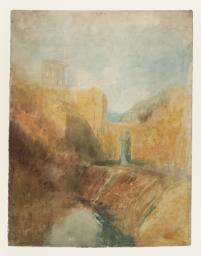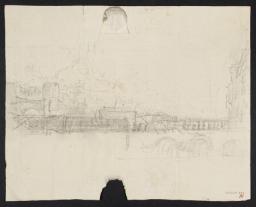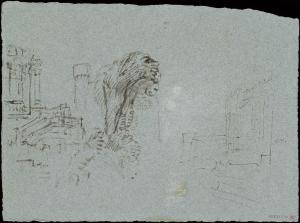Studies of Idealised Italianate Landscapes, and Townscapes and Harbours with Classical Architecture c.1817–45

From the entry
Turner Bequest CXCVI U, CXCVII A, CCXXVII a 15, CCLX 7, 8, 10, CCLXIII 18, 45, 46, 53, 75, 86, 153, 179, 180, 189, 211, 323, 325, CCLXIII a 7, 8, CCCXLIV 331, 363–368, 372, 428, 429, 431–439, CCCLXIV 370, CCCLXV 29 This section comprises a range of mostly generic drawings and colour studies of classical and Italianate subjects ranging from the late 1810s onwards, through to the later stages of Turner’s active career. As some are difficult to date with any precision, they are brought together in a single section, serving as a testament to the artist’s continued dedication to this strand of traditional subject matter as mediated through the work of the Old Masters, counterbalancing his ongoing depictions of contemporary life and technical experimentation. There are three subsections. One contains loosely worked ‘colour beginnings’ of landscapes characterised by glowing sunlit hues, often offset by dark trees to the left or right; some can be related or compared to completed ...
Turner Bequest CXCVI U, CXCVII A, CCXXVII a 15, CCLX 7, 8, 10, CCLXIII 18, 45, 46, 53, 75, 86, 153, 179, 180, 189, 211, 323, 325, CCLXIII a 7, 8, CCCXLIV 331, 363–368, 372, 428, 429, 431–439, CCCLXIV 370, CCCLXV 29
This section comprises a range of mostly generic drawings and colour studies of classical and Italianate subjects ranging from the late 1810s onwards, through to the later stages of Turner’s active career. As some are difficult to date with any precision, they are brought together in a single section, serving as a testament to the artist’s continued dedication to this strand of traditional subject matter1 as mediated through the work of the Old Masters,2 counterbalancing his ongoing depictions of contemporary life and technical experimentation.
There are three subsections. One contains loosely worked ‘colour beginnings’3 of landscapes characterised by glowing sunlit hues, often offset by dark trees to the left or right; some can be related or compared to completed designs of Italian (and in one case British) scenes in oil and watercolour. At least one predates Turner’s first tour of Italy in 1819–20, while others are from around the time of his second extended visit, in 1828–9.4 Another grouping is largely made up of pencil and ink drawings showing classical townscapes, harbours or buildings in landscapes, evoking historical or mythological settings. There is also a range of studies which can be specifically related to Turner’s large painting Dido Directing the Equipment of the Fleet, or The Morning of the Carthaginian Empire, exhibited in 1828 (Tate N00506).5
Many of these works reflect Turner’s enduring admiration for the Rome-based French painter Claude Lorrain (1604/5–1682), whom he greatly admired and often emulated,6 particularly in a series of historical seaport paintings with complex classical architecture, lit by the sun shown low over water within the composition. As well as the Equipment of the Fleet, key examples are Dido Building Carthage; or the Rise of the Carthaginian Empire, exhibited in 1815 (Turner Bequest, National Gallery, London),7 and The Decline of the Carthaginian Empire, shown in 1817 (Tate N00499).8 Such was his devotion to this aspect of his work that the last four paintings Turner exhibited at the Royal Academy in 1850, the year before his death, were variations on the theme: Mercury Sent to Admonish Aeneas (Tate N00553),9 Aeneas Relating his Story to Dido (untraced; formerly Tate N00552),10 The Visit to the Tomb (Tate N00555)11 and The Departure of the Fleet (Tate N00554).12
For a concise survey see Martin Butlin, ‘Classical subjects’, in Evelyn Joll, Butlin and Luke Herrmann (eds.), The Oxford Companion to J.M.W. Turner, Oxford 2001, pp.47–8; see also Kathleen Nicholson, Turner’s Classical Landscapes: Myth and Meaning, Princeton 1990.
See for example David Solkin (ed.), Turner and the Masters, exhibition catalogue, Tate Britain, London 2009.
See Eric Shanes, ‘Beginnings’ in Joll, Butlin and Herrmann 2001, pp.21–3; among many other accounts, see also Andrew Wilton in Martin Butlin, Wilton and John Gage, Turner 1775–1851, exhibition catalogue, Royal Academy, London 1974, p.26; and Andrew Wilton, J.M.W. Turner: His Life and Work, Fribourg 1979, p.187.
For a general outline of the significance of these visits and Italian themes, see Cecelia Powell, ‘Italy’ in Joll, Butlin and Herrmann2001, pp.150–2; see also James Hamilton, Nicola Moorby, Christopher Baker and others, Turner & Italy, exhibition catalogue, National Galleries of Scotland, Edinburgh 2009.
Martin Butlin and Evelyn Joll, The Paintings of J.M.W. Turner, revised ed., New Haven and London 1984, pp.149–50 no.241, pl.243.
How to cite
Matthew Imms, ‘Studies of Idealised Italianate Landscapes, and Townscapes and Harbours with Classical Architecture c.1817–45’, September 2016, in David Blayney Brown (ed.), J.M.W. Turner: Sketchbooks, Drawings and Watercolours, Tate Research Publication, March 2017, https://www



